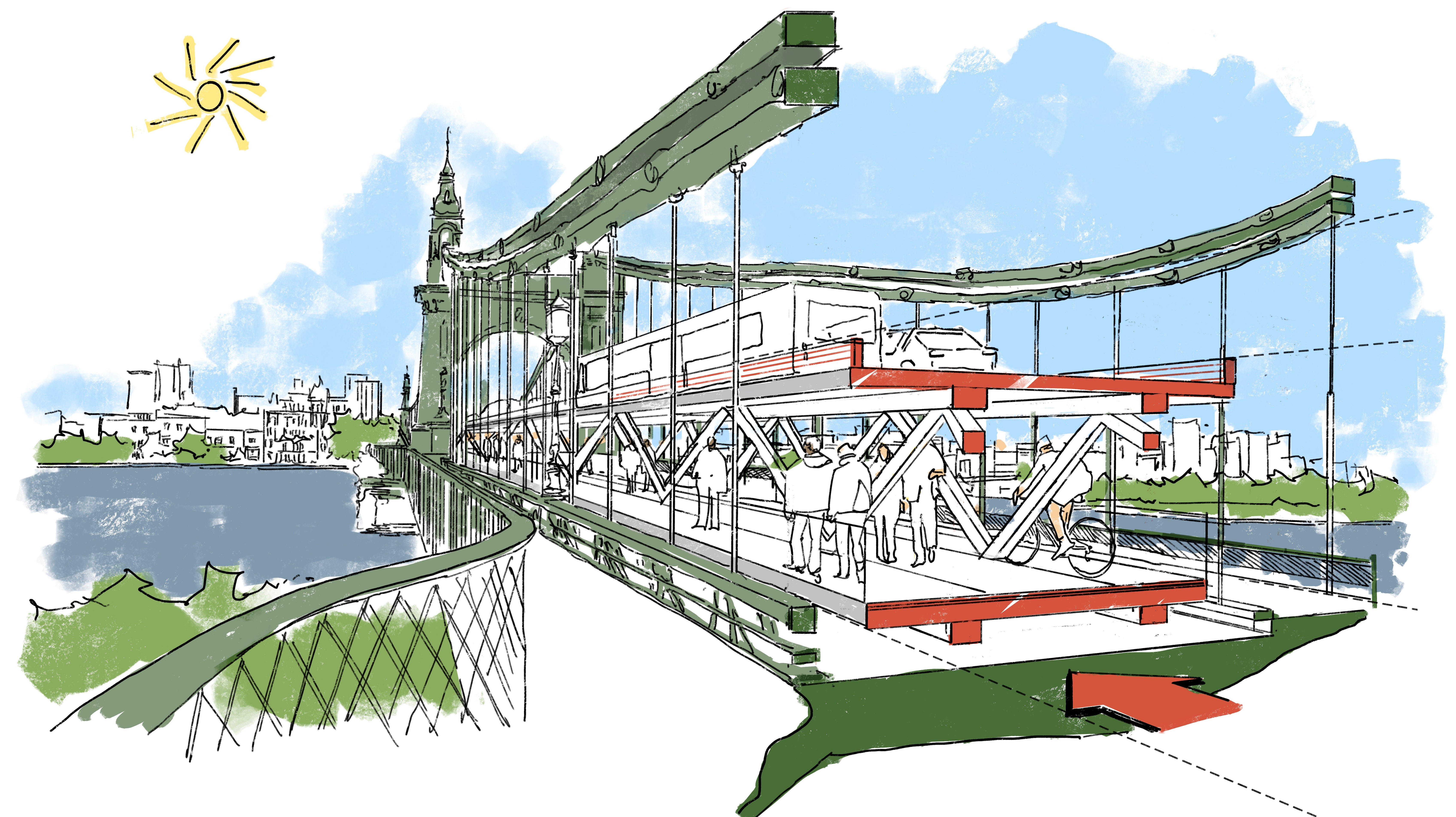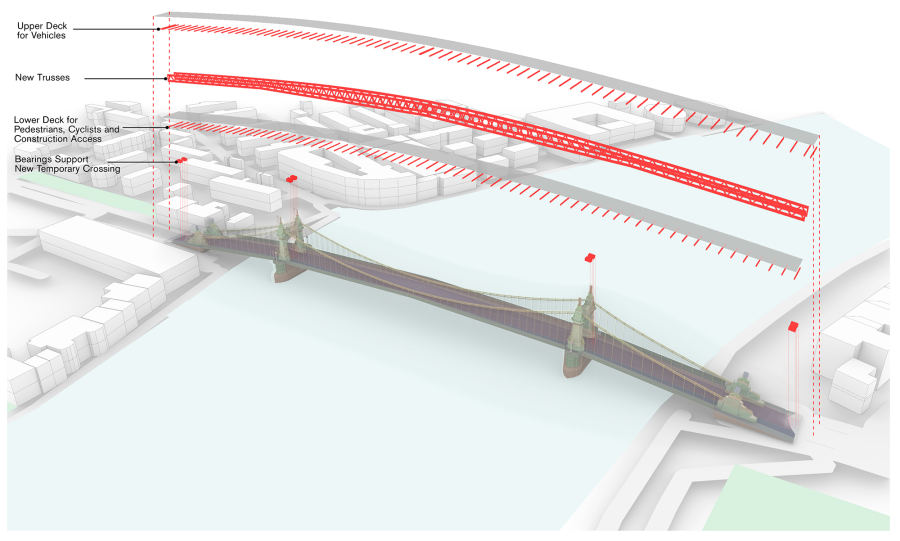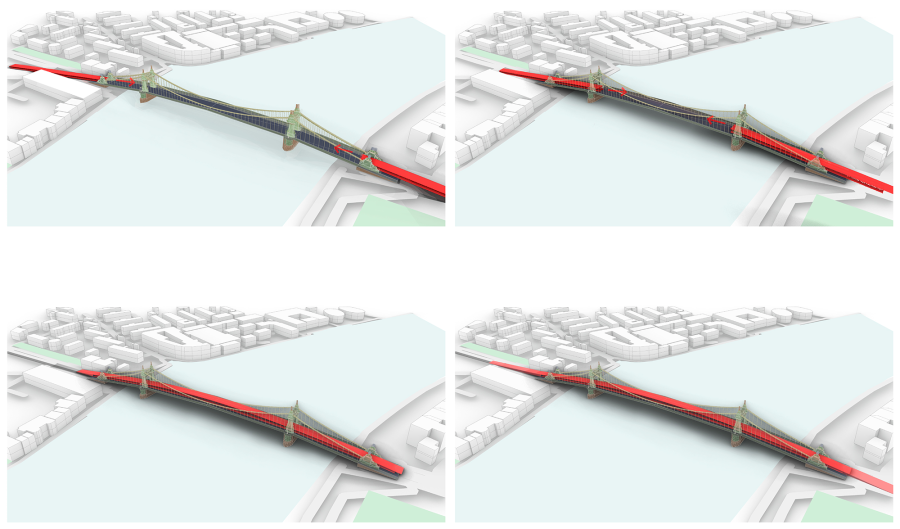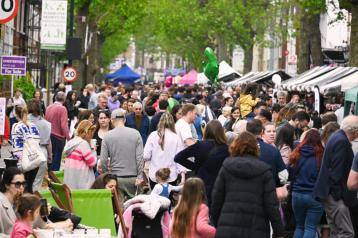
CGI of the new temporary double-decker crossing
Hammersmith & Fulham Council, Sir John Ritblat from Delancey, and world leading architects and engineers Foster + Partners have unveiled a radical new plan to build a temporary double-decker crossing within the existing structure of Hammersmith Bridge that has been closed fully on safety grounds since 13 August.
Under the proposal, pedestrians, cyclists and, potentially, motor vehicles could be using the bridge, with river traffic passing underneath, within a year of a contractor being appointed - much sooner than the previous plan.
A new raised truss structure would be built above the existing road deck featuring a lower level for pedestrians and cyclists and an upper level for cars and buses.
H&F Leader Cllr Stephen Cowan yesterday (25 November) outlined details of the proposed plan to Transport Secretary Grant Shapps and urged the government to give it full consideration.
Sir John Ritblat approached Foster + Partners to develop an alternative plan for the bridge after Stephen Cowan asked for Sir John’s assistance following the bridge’s closure in August.
The concept plan designed by Foster + Partners and further developed with specialist bridge engineers COWI, will be presented to Department of Transport officials today (26 November).

Initial estimates suggest the temporary crossing would allow the strengthening and stabilisation works to the 133-year-old heritage bridge to be completed at a cost lower than the current £141million estimate.
The raised deck would enable existing approach routes for traffic to be used, causing minimum disruption for residents on both banks of the river. The structure will also provide support for the bridge as well as a safe platform for restoration work to be carried out.
There would be no load added to the existing bridge deck which would be removed in stages for repair. Contractors would use the new lower pedestrian deck to access the works. When completed, the temporary raised deck would be removed.
Elements of the Grade II* listed bridge that need repair, including pedestals, anchors and chains, would be lifted away using the temporary bridge and transported by barges to an off-site facility for safe repair and restoration.
By repairing the bridge off-site, the huge task of restoration can be done at greater speed, to a higher level and at significantly reduced cost. It would also minimise noise, environmental impact and onsite activity, as well as reducing the all-important carbon footprint of the works.
Historic England approval would need to be sought for this scheme which enables the bridge to be restored to its original Victorian splendour with fewer constraints.

Cllr Cowan said: “I am extremely grateful to Sir John Ritblat for responding to our call for help so comprehensively. The Foster + Partners and the COWI design team have developed an exciting and imaginative initiative which has the very strong possibility of providing a quicker and better value solution than any of the other proposals.
“Our engineers have held positive and constructive talks with Foster + Partners and COWI. I am optimistic that we now have a viable option within our grasp that is a win for all. I commend it to the Government in the hope that it will be the catalyst for real progress in funding all the necessary works to the bridge.
“We have been exploring a variety of options since the initial closure to motor traffic in 2019 and now have a proposal which potentially meets our objectives of a fast track, lower cost, lower noise, lower emission solution that would lead to an earlier reopening of the bridge.
“I was pleased to be able to deliver the news of the project to the Secretary of State yesterday and look forward to working with his Taskforce to find a solution that works for everyone impacted by the bridge’s closure.”
Luke Fox, Senior Executive Partner at Foster + Partners, said: “We are excited to propose this simple and sustainable solution to this important missing piece of London’s infrastructure that also gives the opportunity to bring back to life a beautiful and iconic bridge by Sir Joseph Bazalgette.”
Roger Ridsdill Smith, head of Structural Engineering at Foster + Partners, said: “We believe that our concept resolves the two challenges for Hammersmith Bridge economically and efficiently: delivering a temporary crossing quickly, whilst providing a safe support to access and refurbish the existing bridge. We appreciate the engagement and contribution from the technical experts in charge of the bridge and look forward to further studies to develop the scheme.”
David MacKenzie, Executive Director at COWI, said: “We consider that this approach is practical and viable. Our experience is that offsite refurbishment of bridge structures is safer and more controlled, and results in a higher quality final outcome when the structure is re-installed.”




